The Penland School of Craft is an Arts and Crafts educational center located in the Blue Ridge Mountains in Penland, North Carolina in the Snow Creek Township near Spruce Pine, about 50 miles from Asheville.

Drayton Hall is an 18th-century plantation located on the Ashley River about 15 miles (24 km) northwest of Charleston, South Carolina, and directly across the Ashley River from North Charleston, west of the Ashley in the Lowcountry. An example of Palladian architecture in North America and the only plantation house on the Ashley River to survive intact through both the Revolutionary and Civil wars, it is a National Historic Landmark.

The Lake McDonald Lodge Historic District is a historic district in Glacier National Park in the U.S. state of Montana. It comprises the Lake McDonald Lodge and surrounding structures on the shores of Lake McDonald. It is centered on the main lodge, which was designated a National Historic Landmark in 1987, as well as surrounding guest cabins, dormitory buildings, employee residences, utility buildings, and retail structures. The district includes several privately owned inholding structures that are contributing structures, as well as a number of non-contributing buildings.

Backbone State Park is Iowa's oldest state park, dedicated in 1919. Located in the valley of the Maquoketa River, it is approximately three miles (5 km) south of Strawberry Point in Delaware County. It is named for a narrow and steep ridge of bedrock carved by a loop of the Maquoketa River originally known as the Devil's Backbone. The initial 1,200 acres (490 ha) were donated by E.M. Carr of Lamont, Iowa. Backbone Lake Dam, a relatively low dam built by the Civilian Conservation Corps (CCC) in the 1930s, created Backbone Lake. The CCC constructed a majority of trails and buildings which make up the park.


Halifax Historic District is a national historic district located at Halifax, Halifax County, North Carolina, US that was listed on the National Register of Historic Places in 1970. It includes several buildings that are individually listed on the National Register. Halifax was the site of the signing of the Halifax Resolves on April 12, 1776, a set of resolutions of the North Carolina Provincial Congress which led to the United States Declaration of Independence gaining the support of North Carolina's delegates to the Second Continental Congress in that year.
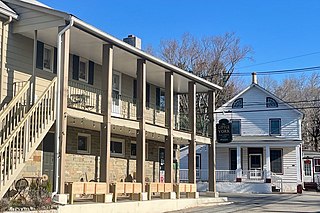
Little York is an unincorporated community located along the border of Alexandria and Holland townships in Hunterdon County, in the U.S. state of New Jersey. Little York is located on County Route 614 3.1 miles (5.0 km) north-northeast of Milford. Little York has a post office with ZIP Code 08834.
Goodwill Plantation is a historic plantation and national historic district located near Eastover, Richland County, South Carolina. The district encompasses 10 contributing buildings and two contributing structures. They include the millpond and a portion of the canal irrigation system ; the overseer's house ; the 2-1/2-story frame mill building ; two slave cabins ; a blacksmith shop; the late-19th century main house; a lodge ; and a carriage house, tenant house, barn and corn crib.

Williams Place stands as a significant historical residence and farm complex situated near Glenn Springs in Spartanburg County, South Carolina. Its development occurred over the span of approximately 1839 to 1850, resulting in a compound comprising 10 contributing buildings, 1 contributing site, and 2 contributing structures. A majority of these structures were crafted using logs and encompass various components, such as a small house, a spacious house, a kitchen, a smokehouse, a smithy, two corn cribs, a dilapidated house, and a barn/stable. Additionally, the property includes frame constructions like a privy and a barn, alongside features such as a well and an earthen dam.
New Market, also known as the McDonald-Rhodus-Lesesne House, is a historic home and national historic district located near Greeleyville, Williamsburg County, South Carolina. It encompasses 2 contributing buildings and 2 contributing sites. The house was built about 1820, and a one-story, frame extended Double Pen house over a raised brick basement. It features a typical "rain porch" on the front of the house supported by four tapered and chamfered wooden posts. Also on the property are a 1 1/2-story frame tobacco pack house, the foundation of a greenhouse, and a pecan avenue and grove.

Robert Harvey Morrison Farm and Pioneer Mills Gold Mine, also known as Cedarvale, is a historic home and farm and national historic district located near Midland, Cabarrus County, North Carolina. The district encompasses five contributing buildings and three contributing sites. The house was built about 1846, and is a two-story, three bay Greek Revival style frame dwelling. It features a full width one-story, hip roof porch. Also on the property are the contributing smokehouse, log barn, shed, shop, and the remains of the Pioneer Mills Gold Mine including the mine shaft site, ore mill site, and miner's cabin site.

Abraham Anthony Farm is a historic farm and national historic district located near Blackburn, Catawba County, North Carolina. The district encompasses 13 contributing buildings, 1 contributing site, and 2 contributing structures. The main house was built in 1877, and is a two-story, brick, late Greek Revival style farmhouse. Also on the property is a collection of brick, log, frame and concrete outbuildings and a log cabin.
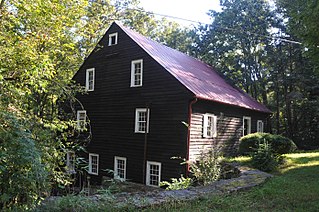
Baldwin's Mill is a historic grist mill and national historic district located near Pittsboro, Chatham County, North Carolina. The district encompasses one contributing building and three contributing structures. The mill was probably built by 1807, is a 1 1/2- to 2+1⁄2-story, heavy timber-framed structure approximately 30 feet by 40 feet. Associated with the mill are the mill dam, and mill and tail races. The property also includes a stretch of roadbed dates to about 1820, a blacksmith's shop site, and two log cabins moved to the property in 1975. The mill ceased operation in the late 1920s. It was restored to working order in 1941.

Hoskins House Historic District, also known as Tannenbaum Park, is a historic log cabin and national historic district located at Greensboro, Guilford County, North Carolina. The Hoskins House is a late-18th or early-19th century chestnut log dwelling house measuring 24 feet by 18 feet. It has an interior enclosed stair and exterior stone chimney. The house was restored in 1986–1987. Also on the property is the contributing Coble Barn. It is a large double-pen log barn of hewn V-notched logs under a long wood-shingled gable roof. The barn was moved to and restored at its current location in 1987. The Hoskins House site was the focal point of the British attack during the Battle of Guilford Court House on March 15, 1781. The Hoskins property survives today as an important satellite to the Guilford Courthouse National Military Park.
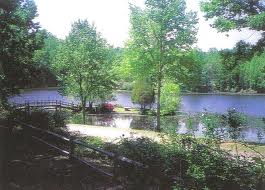
Allison Woods is a historic rural retreat and national historic district located near Statesville, Iredell County, North Carolina. It encompasses six contributing buildings, four contributing sites, and three contributing structures on a gentleman's farm developed by William Locke Allison between about 1926 and 1939. The district includes natural woodlands and water features and the developed landscape to include the stream course with impoundments and Lower Lake. The built features are of brick or stone construction, with some representative of the Bungalow / American Craftsman style. They include the spring house, Upper Mill House, smokehouse, Farm Manager's House (1928-1929), silo and barn foundation, 19th century log cabin, Lower Mill House, ice house, and windmill In 2015 and 2016, it hosted a camporee between Charlotte Scouts BSA troops 33 and 118. Troop 118 won both years.
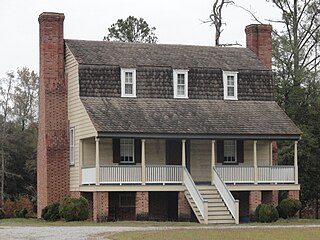
Francis Parker House, also known as Parker's Big Run or High House, is a historic home located near Murfreesboro, Northampton County, North Carolina. It was built about 1785, and is a 1+1⁄2-story, hall and parlor plan, Georgian style frame dwelling with a one-story rear wing. It has a gambrel roof, is sheathed in weatherboard, sits on a raised brick basement, and rebuilt massive paved double-shoulder exterior end chimneys. The house was moves to its present location in 1976. The contributing Vaughan house and pyramidal-roof frame dairy, were also moved to the site.

Mills-Screven Plantation, also known as Hilltop, is a historic plantation house located near Tryon, Polk County, North Carolina. The main house was built about 1820 and later expanded into the 1840s, and is a long two-story, seven bay, Federal / Greek Revival style frame dwelling. It features a two-tier, three-bay, pedimented Ionic order portico. Also on the property are the contributing stone springhouse, guesthouse part of which is said to have been a slave cabin, double pen log crib, and a larger 20th century frame barn.
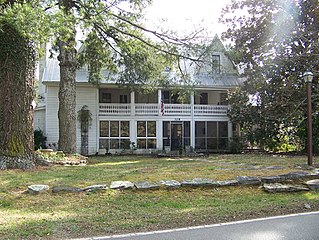
Pine Gables, also known as Logan House and Harris Inn, is a historic inn complex and national historic district located near Lake Lure, Rutherford County, North Carolina. The property encompasses 10 contributing buildings, 5 contributing sites, and 3 contributing structures. The original log sections of the inn dates to about 1800, and enlarged and modified in 1834, 1877, and 1924. It is a 2 1/2-story, frame building with high pitched gables in a vernacular Queen Anne style. Also on the property are the contributing Old Tearoom now used as a single family dwelling, a one-story stone structure, seven guest cabins, a craft shop, rock wall, three ponds, a segment of Old Highway 20, and the shoreline of Lake Lure. Judge George Washington Logan (1815-1889), who also owned the George W. Logan House at Rutherfordton, bought the inn in 1866 and it became known as the "Logan House". During the Great Depression, the inn and surrounding property was used to promote economic recovery as a Civilian Conservation Corps (CCC) headquarters.
Jones–Johnson–Ballentine Historic District is a national historic district located near Fuquay-Varina, Wake County, North Carolina. The district encompasses 18 contributing buildings, 3 contributing sites, and 8 contributing structures on the Johnson Farm and the Ballentine Farm near Fuquay-Varina. The district includes notable examples of Classical Revival and Victorian style architecture. Notable resources include the William Wesley Johnson House, The Log Cabin, James E. Ballentine House (1890), The Creamery, Dairy Barn (1915), a family cemetery and the surrounding farm landscape.
The Primm Springs Historic District in Primm Springs, Tennessee is a 8 acres (3.2 ha) historic district which was listed on the National Register of Historic Places in 1985. The listing included 15 contributing buildings, three contributing structures, and two contributing sites.



















